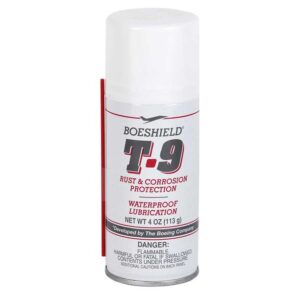
Open Seacock
Seacocks on your KE through hull fittings need to be checked, lubricated, and exercised periodically to ensure they are functioning properly. To keep seacocks functioning reliably, they must be exercised regularly and lubricated at least once a year. Most seacocks today are of the ball-valve type. From fully open to fully closed is one-quarter turn. The handle opens the valve when it is in alignment with the direction of the flow and closes the valve if it is positioned across the flow. There are 8 or 9 seacocks on your KE, depending on your stabilizer set up. The locations of the seacocks are illustrated in the download here :
https://krogenexpress.com/wp-content/uploads/2020/08/Seacock-Locations-1.pdf
]You can download and print this for future reference as well.

Boeshield T-9
Check to see that the body is not loose on the hull. It should be snugged firm to the hull. Each metal seacock should have a green ground wire connected to some part of its body, usually at the base. check to see if the connection is clean, and spray on a little anticorrosive oil. Also check the wire that runs from that terminal. If the strand is green inside the insulation, has lumps under the insulation, or shows other signs of corrosion, it probably is not doing its job well. On most boats, metal seacocks that are not grounded/bonded can suffer from galvanic corrosion. Open and close all your seacocks regularly. If you feel them tightening up or becoming excessively loose, have them checked. It may just be debris in the hole or a nut backing off, or there may be an internal issue with the seacock. Try to wiggle the handle. It should not wiggle much, if at all. If it does, the shaft that attaches it to the inner valve may be corroded or otherwise compromised. While exercising your seacock from the open to close position, generously spray anti corrosion spray and lubrication onto the handle, nut, and entire seacock. Any waterproof lubricant with rust and corrosion protection, such as Boeshield T-9, will work well. Check the two hose clamps (some fittings only have room for one) and ensure they are not corroded. You also want to ensure they are not crimping the hoses and are firmly snugged onto the hose and fitting.
Some quick checks and maintenance of your seacocks will ensure their proper function, ensure longevity, and prevent a major issue when the time comes that you have to close the seacock.
